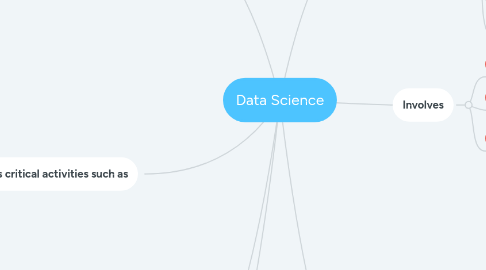
1. Closely related processes
1.1. Data-Driven decision making (DDD)
1.1.1. Refers to
1.1.1.1. the practice of basing decisions on the analysis of data rather than intuition
1.1.2. Benefits include
1.1.2.1. increase in productivity
1.1.2.2. higher return on assets
1.1.2.3. higher return on equity
1.1.2.4. higher asset utilization and market value
2. Needs critical activities such as
2.1. Data Engineering
2.1.1. is used in tasks that includes
2.1.1.1. Big data
2.1.1.1.1. used for
2.1.1.1.2. Which increases
2.1.1.1.3. Establishes
2.2. Processing
2.2.1. important to
2.2.1.1. business tasks that do not involve extracting knowledge or DDD
2.2.1.1.1. Such as
2.3. Data-analytic thinking
2.3.1. for people such as
2.3.1.1. Line employees
2.3.1.2. managers
2.3.1.3. Investors
3. Ask
3.1. Is this reasonable?
4. Complications of understanding concepts include
4.1. death of academic programs focusing on data science
4.1.1. due to
4.1.1.1. the inertia associated with academia
4.1.1.2. the concomitant effort involved in creating new academic programs
5. Applied to
5.1. Marketing
5.1.1. For tasks such as
5.1.1.1. Targeted marketing
5.1.1.2. Online advertising
5.1.1.3. recommendations for cross selling
5.1.1.4. Organize and understand data-driven campaigns
5.2. General customer relationship management
5.2.1. Must manage
5.2.1.1. data-analytics teams
5.2.1.2. data-analysis projects
5.3. Finance
5.3.1. For tasks such as
5.3.1.1. Credit scoring and trading
5.3.1.2. operations via fraud detection
5.4. Venture capitalists
5.4.1. invest wisely in businesses with substantial data assets
5.5. Business strategistes
5.5.1. devise plans that exploit data
6. Involves
6.1. Principles
6.1.1. For understanding phenomena via the (automated) analysis of data
6.2. Processes
6.2.1. Close interactions between the scientist and business people
6.3. techniques
6.3.1. such as
6.3.1.1. random forests
6.3.1.2. support vector machines
7. Fundamental concepts include
7.1. Extracting useful knowledge from data to solve business problems can be treated systematically by following a process with reasonably well-defined stages
7.1.1. structure our thinking about data analytics problems
7.2. Evaluating data-science results requires careful consideration of the context in which they will be used
7.2.1. Questions to be asked include
7.2.1.1. How are we going to use the patterns extracted from historical data?
7.2.1.2. Does the pattern lead to better decisions than some reasonable alternative?
7.2.1.3. How well would one do with a smart default alternative
7.3. The relationship between the business problem and the analytics solution often can be decomposed into tractable subproblems via the framework of analyzing expected value
7.3.1. Components include
7.3.1.1. Estimating probabilities
7.3.1.2. Computing or estimating values
7.3.1.3. a structure for recombining the components
7.4. Information technology can be used to find informative data items from within a large body of data
7.4.1. "correlations"
7.4.1.1. meaning data items that provide information about other data items
7.4.1.2. Known quantities that reduce uncertainty about unknown quantities
7.5. Entities that are similar with respect to known features or attributes often are similar with respect to unknown features or attributes
7.5.1. by main tool of computing similarity
7.6. If you look too hard at a set of data, you will find something but it might not generalize beyond the data you’re observing
7.6.1. "overfitting"
7.6.1.1. avoidance permeates
7.6.1.1.1. data science processes
7.6.1.1.2. algorithms
7.6.1.1.3. evaluation methods
7.7. To draw causal conclusions, one must pay very close attention to the presence of confounding factors, possibly unseen ones
7.7.1. Use models to guide decisions on influencing the behavior of the data such as
7.7.1.1. interpreting the coeficients of regression models
7.7.1.2. incorporate assumptions regarding the presence or absence of confounding factors
